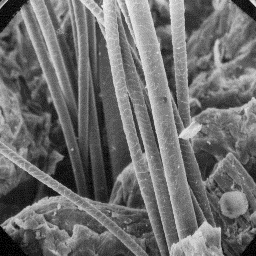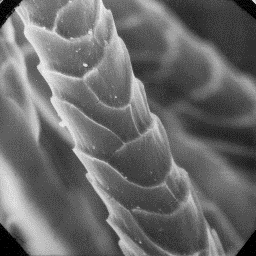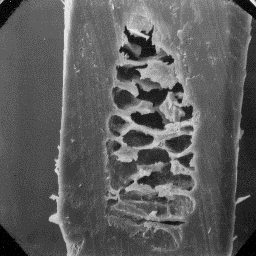 Mephitis mephitis
Mephitis mephitis
-----------------
English: Striped skunk
German: Streifenskunk
French: Moufette
Spanish: Mofeta
Distribution areas
------------------
The striped skunk can be found in North
America in the area between the Hudson Bay
and the Gulf of Mexico. Today, some striped
skunks are also found in the wild in some
areas of Asia, where they were imported by
Man. In Central and South America, some
smaller varieties of skunk are found; about The surface structure
seven varieties are known. of the skin, 200x
Description of the fur
----------------------
The skunks on North America origin have skins measuring 30 to 100 cm. The
fur coat is dense, fine and dark-brown or perhaps black in colour. On the
neck, there is a long, forkshaped spot, the branches of which are connected at
the back. The size of spot varies in different animals and, in some cases, may
not be apparent. The under coat is dark, about 5 to 12 mm thick, and is
composed of moderately curled fine fibres.
|
|
 Mephitis mephitis
Mephitis mephitis
-----------------
English: Striped skunk
German: Streifenskunk
French: Moufette
Spanish: Mofeta
The coarse fibres are lighter in shade in
the centre; the tips are dark and lustrous.
The guard hairs length is from about 25 to
35 mm.
Structure of the hair
---------------------
The microscopic structure of the skin
surface is furrowed. The hair follicles are The cuticular structure
usually narrow with straight edges. The of the fine fibres, 1200x
average follicle contains a cluster of 5 to
9 fibres.
The fine fur fibres have a diameter in the range of 15 to 30 µm. The cross-
section are circular in the lower parts, and usually ellipsoidal in the other
parts, of the shaft. The cuticle is composed of even tile-like or rounded
tile-like scales with a smooth scale surface and straight margins. The
medullar column is not visible in the lower part of the shafts but is present
over the rest of the shaft's length.
|
|
 Mephitis mephitis
Mephitis mephitis
-----------------
English: Striped skunk
German: Streifenskunk
French: Moufette
Spanish: Mofeta
It is narrow, unbroken and symmetrically
located in the central axial area of the
fibre. The medullar structure belongs to the
uniserial ladder type with an amorphous
infilling substance.
The intermediate fibres are ellipsoidal
in cross-sectional outline, and the diameter
is between 30 to 50 µm. The cuticular scales Longitudinal section
are even tile-like in shape with a smooth or of a fine fur fibre, 1000x
sometimes non-regular grooved surface. The
scale margins are straight. The medullar column is wide, unbroken and central
symmetrical-shaped in cross-section. The overall structure of the medulla
belongs to the non-symmetrical non-uniform lattice type with a complex-sheet-
like infilling material.
|
|
 Mephitis mephitis
Mephitis mephitis
-----------------
English: Striped skunk
German: Streifenskunk
French: Moufette
Spanish: Mofeta
The guard hairs are ellipsoidal in cross-
section; the diameter is between 50 and
120 µm. The cuticle has crenated tile-like
scales with a smooth or sometimes non-
regular grooved scale surface. The scale
margins are rippled. The medulla is wide,
unbroken and symmetrically located in the
central axial area of the fibre. The overal
medullar pattern belongs to the lattice type The transverse section through
with an infilling material of a sheet-like an intermediate fibre, 600x
or coplex-sheet-like detailed structure.
|
|
 Mephitis mephitis
Mephitis mephitis
-----------------
English: Striped skunk
German: Streifenskunk
French: Moufette
Spanish: Mofeta
Transverse section of a guard
hair, 600x
Numerical code for skunk skin structure
---------------------------------------
Surface of the skin: 3-4-3
Fine fur fibres: 2.1-2.3-1-1-3-1-1-1-8-15.30-5.18
Intermediate fibres: 2-2-1.2-1-2-1-1-10-4-30.50-15.25
Guard hairs: 2-4-1.3-2-2-1-1-8-1.4-50.120-20.35
|




